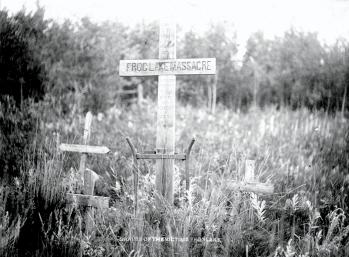
Although it was not a military engagement, the incident known as the Frog Lake Massacre proved to be one of the most influential events associated with the North-West Resistance. Incited by hunger and mistreatment rather than political motives, a breakaway element of the Plains Cree murdered nine White men on the morning of April 2, 1885, in Frog Lake (now Alberta), North-West Territories. Big Bear, chief of the Plains Cree in the region, sought improved conditions for Treaty Indians through peaceful means and unity among the tribes. However, the food shortage that followed the virtual extinction of the buffalo left his people near starvation and weakened his authority. Disaffection focused upon Thomas Quinn, an Indian agent who treated the Cree with harshness and arrogance. Before dawn on April 2, a party of warriors captured Quinn at his home. The Cree, led by war chief Wandering Spirit (Kapapamahchakwew) and Ayimâsis, Big Bear’s son, took more prisoners as they occupied the village. Shortly before 11 a.m., the prisoners were ordered to move to an encampment about 2 km from Frog Lake.
When Quinn obstinately refused, Wandering Spirit shot him in the head. In the short minutes of panic that followed, eight more prisoners were shot dead: sawmill operator John Gowanlock, Farming instructor John Delaney, Catholic priests Rev. Leon Fafard and Felix Marchand, clerk William Gilchrist, trader George Dill, carpenter Charles Gouin, and John Williscroft, Father Fafard’s lay assistant. Cree women hid William Cameron, a Hudson’s Bay clerk, beneath a large shawl and thereby saved his life. Cameron, Theresa Delaney and Theresa Gowanlock, widows of two of the slain men, their families, and others from the settlement, numbering 70 in all, were taken as captives. The Cree then moved on to occupy Fort Pitt. At the conclusion of the 1885 Resistance, six Cree men were tried and sentenced to death for their roles in the Frog Lake Massacre: Bad Arrow (Manchoose), Iron Body (Nahpase), Little Bear (Apischaskoos), Miserable Man (Kitahwahken), Walking the Sky (Pahpahmekeesick), and Wandering Spirit. They, and two Cree men condemned for a murder committed on March 29, just before the Siege of Battleford, were hanged on November 27, 1885, at Fort Battleford, in the largest mass execution in Canadian history.
John Chaput
Print EntryBeal, B. and R. Macleod. 1984. Prairie Fire: The 1885 North-West Rebellion. Edmonton. Hurtig.
HOME | BROWSE BY SUBJECT | ENTRY LIST (A-Z) | IMAGE INDEX | CONTRIBUTOR INDEX | ABOUT THE ENCYCLOPEDIA | SPONSORS TERMS OF USE | COPYRIGHT © 2006 CANADIAN PLAINS RESEARCH CENTER, UNIVERSITY OF REGINA | POWERED BY MERCURY CMS |
|||
| This web site was produced with financial assistance provided by Western Economic Diversification Canada and the Government of Saskatchewan. |
|||
 |
 |
 |
 |
| Ce site Web a été conçu grâce à l'aide financière de Diversification de l'économie de l'Ouest Canada et le gouvernement de la Saskatchewan. |
|||